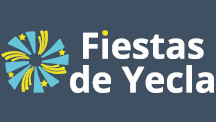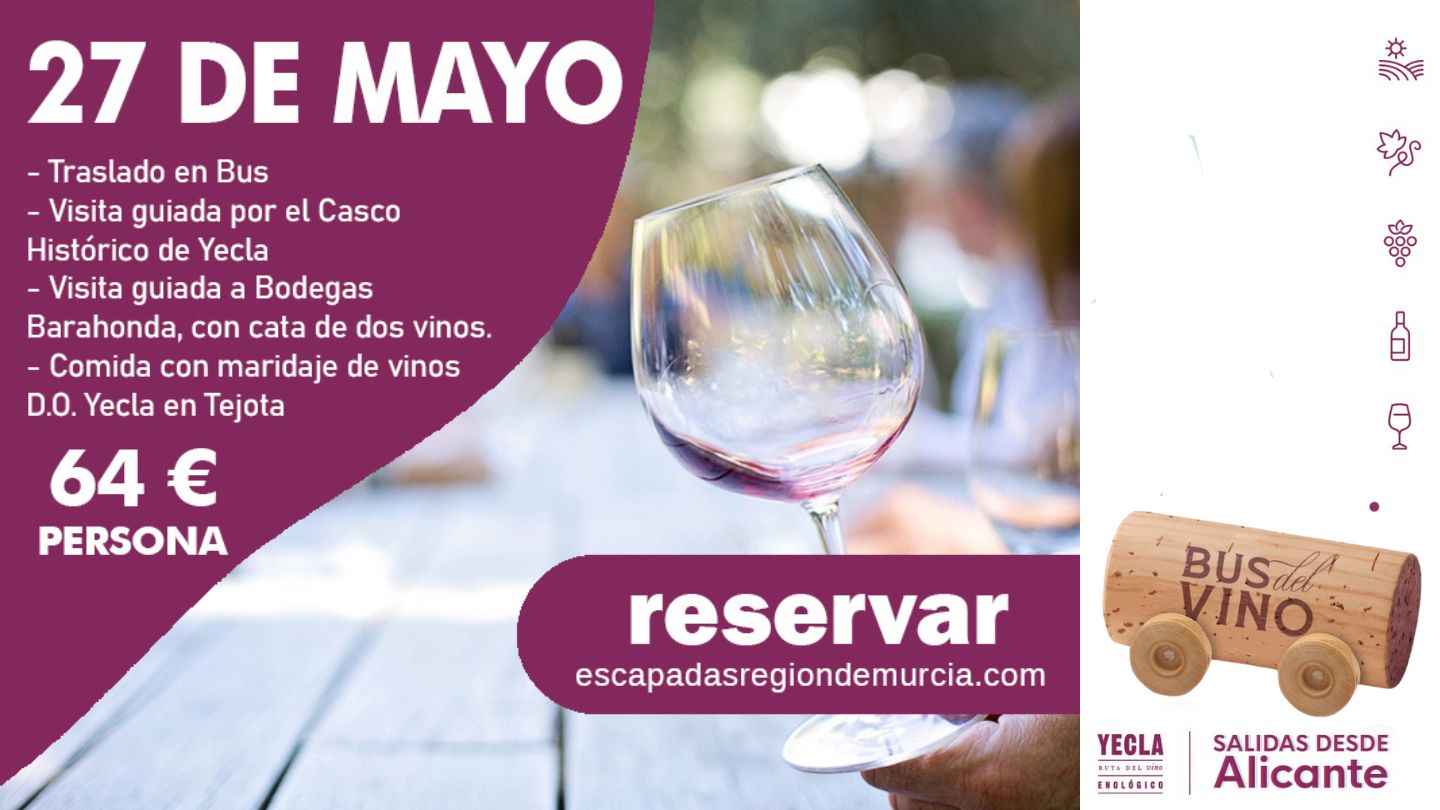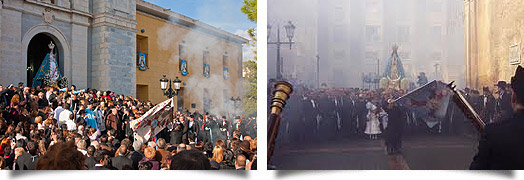
Patron Saint Festivals declared of National Tourist Interest
The Patron Festivities of Yecla, have their origin in the recruitment of a company Yecla under the command of Captain Martin Soriano Zaplana, who march to the «War of Catalonia» in 1642, called by the King. After six months of stay in the garrison post of Vinaroz, they return without incident.
The religious sentiment of those Yeclans brought them, in an attitude of gratitude, for the bloodlessness of their expedition, to go up to the Sanctuary of the Castle, in thanksgiving, before the image that then existed of Our Lady of the Incarnation and since then , every year, they descend to the Patron, firing with arquebuses in their honor , to the then Parish of the Assumption. In the year 1786 the first Ordinances of the Patron Saint Festivities were enacted, of obligatory character, referred to the action of the soldiery, establishing the most representative acts and figures of the Festivities. These Ordinances were renewed by new ones in 1986. Already in the S. XIX, with the inauguration, in 1868 of the Basilica of the Immaculate , it is determined that from that year, the Virgin is staying in this Church during the days of the Holidays .
In our century, the parish priest, Archpriest José Esteban Díaz, was the current Association of Mayordomos de la Purísima Concepción in 1932, an entity that is responsible for organizing festive events. In 1954 the Canonical Coronation of the Virgin of the Castle is proceeded, by decision of Pope Pío XI. Since then, the roots of the party among Yecla have been continuously increasing, bearing fruit such as the Flower Offering, the activities of the various squads, the proclamation, the cultural events of May and November, etc.
The Celebrations of Yecla, begin on December 5 with the so-called act of goodwill, in which the President of the Association of Mayordomos asks permission to the first municipal authority to start the Fiestas. In the afternoon, halberdiers and drummers invite the neighborhood to join the party. On the 6th in the morning , the Mass of Pajes is celebrated, and in the afternoon the Kiss of the Flag of the whole soldiery. The Day of the Descent , begins with the Alborada , in the atrium of the Basilica of the Immaculate Conception and then go on, always firing the arquebuses, to the Shrine of the Castle, from which proceed to the transfer of the Patron of Yecla to its Basilica. In the tour, the Butler plays the Flag before the Virgin , at the exit of the Sanctuary, in the so-called Paso de la Bandera and at the entrance to the Basilica, while the arquebuses , without interruption, intensify their shooting. That same day, in the afternoon, the different squads come to the act of the Flower Offering , after a tour of the downtown streets of the city.
On December 8, the great day of these Festivals , the proclamation of clavarios and the parade of the soldiery, gives way to the Procession with the image of the Patron , in which the Mayordomo repeats the same ritual with the Flag, at the exit and especially at the entrance of the Virgin to the Basilica, in the middle of a deafening roar of all the arquebus firing .
Finally, La Subida, is celebrated on the Sunday following the eighth . In the morning solemn religious function, after the emotional and ancestral "Minerva" in it the Blessed Sacrament blesses all the faithful while the Butler of the Flag does not stop playing in the midst of the thunderous noise produced by the " closed coffers ." In the afternoon, after the joy of having been visited by the Patron, she is accompanied to her sanctuary, once in the esplanade she goes three times around the centenary pine and enters her hermitage giving the face and her blessing to the city . This moment is accompanied by the game of the flag and the inextinguishable roar of the arquebuses.
After the descent of the soldiery the Delivery of Badges is celebrated, in her the Clavarios happen to be Mayordomos , one of the Staff, that represents to the captain Martin Soriano Zaplana and another one of the Flag and that represents the ensign standard-bearer that back in 1642 gave origin to these unique and emotional parties. All the members of the procession, wear the regulation uniform consisting of a black hat, pants and bow tie of the same color and the shirt, white. The Butler of the Staff, represents the Captain Martin Soriano Zaplana and the Butler of the Flag, to the standard-bearer of the Company. The Pages, the halberdiers, the corporals of the company, etc. They complete the elements of the party where the regulatory weapon to carry out the salvos with gunpowder is the arquebus, with a brass mouthpiece with an open cup shape and a wooden butt.
Holy Week declared of Regional Tourist Interest
Seventeen Brotherhoods and Brotherhoods, seven bands of cornets and drums, several bands of music, more than two thousand capuchins, procession through the streets of the city, accompanying thirty-one processional steps in the nine processions that are celebrated . During Lent, preceding the Major Week, the cults to the titular images will have been celebrated. The Besamanos, Via Crucis, Triduos y Septenarios, visits, etc. Other activities will also be behind: Nazareno of the Year, Senior Honorary Brothers, presentation of the poster, Magazine-Program, exhibitors and concerts ... The Cabildo Superior de Cofradías Pasionarias, along with all the brotherhoods and surrounded by the village, celebrates Holy Week year after year, is characterized by its order and religiosity. Some peculiar parades that make it unique, such as the procession of the "Farolicos" , the emotional acts of "La Cortesía" and "El Encuentro", the "Burial of the Christ" and the unparalleled procession of "La Soledad". The traditional roots of these parades, the efforts of the Cabildo and the Confraternities, and the Yeclano people turned towards these manifestations, have deserved that our Holy Week, once declared of Tourist Interest.
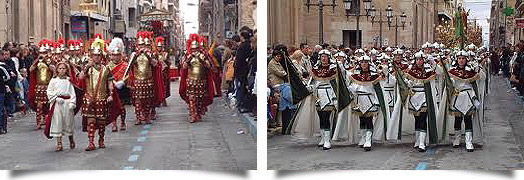
The first celebrations were made in the time of Philip II. In the seventeenth century, the first penitents with robes appear, as well as the Brotherhoods of Solitude and the Brotherhood of the Cross. It is in the eighteenth century, when before celebrating the procession of the Entombment of Christ, two sermons were made; the one of the Descent and the one of the Solitude. This Procession of the Burial, will give origin to the parades as we know them at present, and that take their definitive form in the second half of the XIX century. During the events of our Civil War, almost all the artistic heritage of Holy Week was lost. After the battle, the Brotherhoods reorganize again, after difficult years, the splendor of our processions arrives.
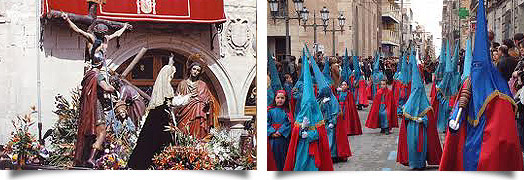
The new times have given way to the creation of new brotherhoods, losing many of the existing "Guilds" for which they were once known. The religious, together with the traditional and the cultural, confer Holy Week and its own personality, expressed in our streets by its color, recollection and prayer, before the fervor of a whole people that for more than two centuries is faithful to their customs and traditions.
Festivities of San Isidro declared of Regional Tourist Interest
In the middle of the month of May , Yecla recovers its agricultural tradition, with the celebration of the Fiestas de San Isidro . These celebrations have an important root in a city that until the middle of the s. XX, was dedicated to the collection and elaboration of excellent wines and appreciated oils.
The origin of these holidays is located in the middle of s. XIX , moment in which the birth of the well of San Isidro takes place. In the 1940s the celebration evolved by the arrival of an image of this saint that is located in the Basilica of the Immaculate. Shortly after, the Great Parade Ride is celebrated, which over the years becomes the central act of these celebrations. At present, the work of the Peñas and the own Council of Celebration has allowed to reach the maximum levels of participation known.
The different acts that make up this celebration, begin with the election of Queens and Ladies of the Holidays which will follow the proclamation of the Queens and Ladies and Children. It is the moment in which the Proclamation of the Holidays is also carried out . During the month of May Eucharistic celebrations dedicated to the saint, festivals, parades, performances of the folkloric groups of our city, musical performances, and especially the Great Cavalcade of Carriages, held on the Saturday closest to the festival of San Isidro.
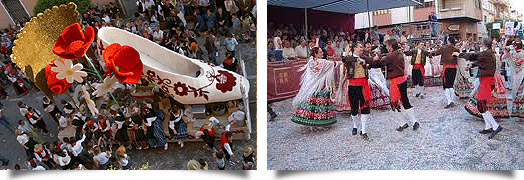
This Great Cavalcade is gestated thanks to the intense work to develop the Carrozas de las Peñas , since after having the design and the metallic or wooden structures, which are mounted on trailers of tractors , they have to decorate them with tiny pieces of tissue paper or manila of about seven centimeters, which wrinkles and compresses to cover the structures, some of them with dimensions of five and a half meters in height, and a width of between three meters and six meters in length; representing aspects of farming or related to it .
In the parade , the members of the peñas dress with the typical costume , the streets are filled with colors by the confetti, they are distributed among the attendants wine, and products of the land .
In addition, prizes are awarded for the best floats at the end of the ride. For all this, San Isidro becomes one of the liveliest parties in our city .
Contact:
- Federation of Peñas de San Isidro.
- PO Box 633, 30510-Yecla (Murcia).
- Phone: +34 608 500 792
- Web: www.federacionsanisidro.com
- E-mail:
- Blog: sanisidroyecla.blogspot.com
Other Fairs and Festivals
Weekly Market of Wednesdays , privilege granted by the Catholic Monarchs, has been celebrated in Yecla, without interruption, since the end of the 16th century. Originally it was celebrated on Tuesdays but, very soon, it was changed on Wednesdays and if that day was a holiday, it moves to the previous day.
Artisan Market , in the Plaza Mayor, ethnographic works and products are exhibited on the last Sunday of each month.
Fiestas de San Antón , in the month of January. Stresses the blessing of animals, in the Church of the Hospital, also held a procession through the streets of the city, in addition to releasing pigeons and Pan del Santo cooks.
Fiesta de San Blas , celebrated the first weekend of February and stand out on Saturday afternoon in which at the end a bonfire is made in front of the niche of the Saint in the street of the Church and young people jump over it . On Sunday morning there is a procession in which thousands of people accompany the Saint carrying "blessed bread." It is estimated that ten thousand are made; This consists of a bread sobado and kneaded with sugar. Tradition says that before eating it, a Paternoster is prayed to avoid throat problems. In the afternoon the most jovial and entertaining acts are held in the Plaza Mayor: sack races, cucañas, piñata, comic chocolate, etc.
Carnival , highlights the Great Parade on Saturday night carnival through the streets of the city, as well as parades and parades for children.
Pilgrimage of San Marcos , it is celebrated in the Hill of the Source, in the month of April, with the celebration of a farming mass, local folk dances and popular games, Festival of Paellas, contest of Gachasmigas and petanque championship.
Festivities of the Judas , is celebrated at the beginning of May, on the occasion of the invasion of the French troops during the War of Independence, at the beginning of the 19th century. Hang in the middle of the streets the typical "Judas", with satirical posters that refer to the political and social situation, causing popular rejoicing. They are accompanied with dances and theater, tasting of typical Yecla dishes, guiñoles, etc.
Festivities of San Cristóbal , on the weekend closest to July 10 this festival is celebrated with honor to this Saint, patron of the transporters. Highlights the Cavalcade of Trucks throughout the city, sports and coexistence activities.
Feria de Septiembre , is among the privileges granted to Yecla by Infante D. Juan Manuel. Confirmed by D. Juan I in 1389, it was fifteen days, coinciding with the fiestas of San Martín. Later it was changed to dates close to the San Marcos party. Felipe V in Yecla's fidelity award confirmed this privilege by transferring it back to November. In 1839 the transfer was requested and secured on September 18. Already at the end of the last century it lost its commercial transaction character, to become little by little a reason to celebrate, public celebrations, leisure, cultural and sports attractions.
Festivities of Raspay , is the only hamlet of Yecla, located 25 km on the road from Yecla to Pinoso. Its physiognomy is changing because it is a residence for more and more English people, Irish people, etc. Celebrations are held at the beginning of September, on the occasion of their patron saint festivities.
Furniture Fair , began in 1962 to give output and serve as a showcase and shows the manufactured and wood crafts. It is currently held in March and is an unmissable annual event for professionals in the sector.



